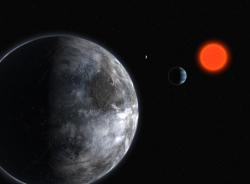 Great big Jupiter-like planets are one thing, but the Holy Grail of extrasolar planetary discover is going to be another Earth – complete with life. We’re not there yet, but astronomers announced the next best thing yesterday: a roughly Earth-mass planet orbiting within the habitable zone of its parent star. In other words, liquid water could exist on this rocky planet.
Great big Jupiter-like planets are one thing, but the Holy Grail of extrasolar planetary discover is going to be another Earth – complete with life. We’re not there yet, but astronomers announced the next best thing yesterday: a roughly Earth-mass planet orbiting within the habitable zone of its parent star. In other words, liquid water could exist on this rocky planet.
The host star is called Gliese 581, and it’s one of the 100 closest star to us, located only 20.5 light years away in the constellation Libra. Unlike our Sun, it’s a red dwarf star, emitting much less light and energy. This brings its habitable zone in close and tight to the star. For a planet to be orbiting its parent star within this habitable zone, it’s got to have a really tight orbit.
And this is how the planet was discovered. It was made by measuring the star’s radial velocity, where the planet’s gravity tugs its parent star back and forth (aka, the Wobble Method). Astronomers can measure this velocity with tremendous precision to determine the planet’s mass and orbital period. And the tool for the job is the European Southern Observatory’s HARPS (High Accuracy Radial Velocity for Planetary Searcher) spectrograph connected to the 3.6-m telescope at La Silla, Chile.
The planet is “Earth-like”, but it wouldn’t seem much like home. It’s 50% larger than the Earth, and has about 5 times our planet’s mass. It also completes an orbit every 13 days – it’s 14 times closer to its star than the Earth is to the Sun. Since it’s in the habitable zone, there would very likely be liquid water on its surface.
Unfortunately, the radial method only tells astronomers what the planet’s mass and orbital distance are. They’re not directly observing it. So there’s no way to know if there is actually water on the surface, or even oxygen in the atmosphere that would indicate the presence of life. But future missions, like Darwin, will certainly put it in the cross hairs to get a better look for life.
The discovering team think that turning up an Earth-sized planet around a red dwarf star is now just a matter of time.
Original Source: ESO News Release
